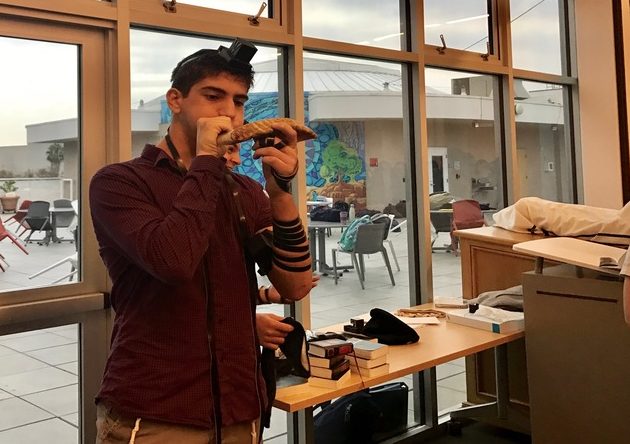Not just apples and honey: Sephardic Rosh Hashanah
SHOFAR: Asher Dauer blew the shofar in the large Beit Midrash during Hashkama Minyan Sept. 19.
September 19, 2017
By Ilan Bouskila, 12th grade
The beginning of the New Year is an opportunity to wipe the slate clean and start again. Aware of life’s complexities and that no year is ever going to be perfect, Jewish tradition offers us the opportunity to begin anew, with the hope that any negativity from our past will be wiped away, and that we will hopefully avoid all potential negativity in the coming year.
In the Sephardic tradition, the first night of Rosh Hashanah is filled with prayers and symbols whose theme is the ushering in of a blessed year. The Arvit (evening) prayers on Rosh Hashanah open with a beautiful liturgical poem – Ahot Ketanah, meaning “little sister.” Each of its stanzas concludes with the words tikhleh shanah v’kileloteha — may this year and all of its curses come to an end. The finale of the poem is Tahel shanah u’birkhoteha – may this year with all of its blessings now begin.
We then greet each other by saying Tizke l’shanim rabot – May you merit many years (in plural, tizku l’shanim rabot. The response to this greeting is tovot u’neimot – may the many years indeed be good and pleasant.
When it’s time to eat, our Sephardic Rosh Hashanah dinner opens with Kiddush and Hamotsi, but before eating our actual meal, we eat a wide array of symbolic foods whose theme are either the elimination of negativity or the aspiration for blessings. These foods are called the simanim — signs or symbols — and they form what many today call the Sephardic Rosh Hashanah seder.
Each of the simanim was chosen either due to its potential for a creative word play, its physical structure or its sweet flavor. We eat dates, leeks, beets and pumpkin, all of which symbolize the rooting out of negativity. The Hebrew word for date is tamar, and before eating the date we say “She-yitamu oyvenu,” — may our enemies be consumed. Yitamu — consumed — sounds like tamar. The Aramaic term for leeks is karti, and before eating the leeks we say “She-yikartu oyvenu” — may our enemies be cut off; yikartu, cut off, sounds like karti.
The Aramaic word for beets is silka, and before eating the beets we say she-yisalku oyvenu — may our enemies disappear; yisalku — disappear — sounding like silka. We eat pumpkin, which in Aramaic is called kra, and in Hebrew the word kra also means “rip up” — we pray that God will rip up any evil decrees against us.
These simanim reflect our innermost desire to begin a year void of some of life’s most brutal curses: strife, conflict, war and evil.
Another custom is to eat string beans, which when opened are filled with small beans, and we say “May our merits increase” — like the beans that are multiple. There are some who eat the meat of a sheep’s head and say, “May we always be as the head and not the tail.”
My family, dating back to my father’s traditions in Morocco, also has the custom of eating sesame seeds mixed with sugar, and we say, “May our mitzvot – our good deeds — be as abundant as sesame seeds, and our lives as sweet as sugar.”
Of course, there is the apple dipped in the honey — not originally a Sephardic custom. As a variation, some Sephardim cook the apple in honey and sugar. But Sephardic or Ashkenazic and however we express it, we all wish for the same things, a clean slate on which to strive again for a year without negativity, but full of mitzvot, blessings and sweetness.
Tahel shanah u’birkhoteha?













